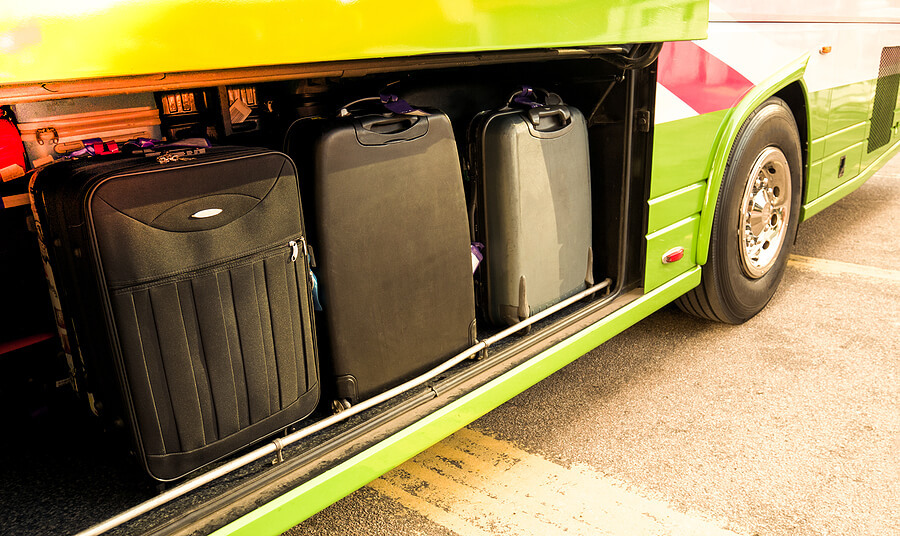When you’re planning a big group trip, you want everyone to travel together comfortably — and on schedule. That’s why many event organizers choose to rent a charter bus! If you’ve never rented a bus before, you may not know where to start. Don’t worry! We’re here to help you every step of the way.

One of the first steps is choosing a bus manufacturer. Each manufacturer is known for its unique features and styles of bus. Keep reading to learn more about four of the most popular charter bus manufacturers in North America.
Motor Coach Industries (MCI)
One of the first things that comes to mind when you think about charter buses? Probably that iconic Greyhound logo! But did you know that Greyhound’s buses are actually manufactured by Motor Coach Industries (MCI)? MCI has been a cornerstone in the charter bus industry since 1933—and since then, it’s become the leading charter bus manufacturer in North America. MCI takes pride in building the most reliable buses on the market. And they do so with a commitment to sustainability, quality-driven engineering, and innovative solutions to meet transportation needs for communities today, and into the future.
The Complete History of Motor Coach Industries (MCI)
Believe it or not, the company behind some of America’s most beloved long-distance coaches actually began in a small Canadian repair shop. It’s a long story, so we’ll keep it concise. The company’s founder Harry Zoltok started by building smaller 11-passenger vehicles for passenger transport and local routes.
He later produced a full line of coaches for Grey Goose Bus Lines—a predecessor to today’s Greyhound Canada. After a brief detour to manufacture war necessities during World War II, Zoltok’s company officially adopted the name of “Motor Coach Industries” in 1941.
MCI expanded into the United States in 1962, opened a factory in North Dakota, and began developing new coach styles. By the late 1960s, MCI had manufactured its first stainless-steel coach and gained recognition for its dependability and durability.
By 1984, MCI had made a notable commitment to accessible travel by adding wheelchair lifts to its vehicles—a revolutionary addition that happened years before the Americans with Disabilities Act was officially passed in 1990. MCI’s dedication to accessibility continued as they incorporated more features like wheelchair lifts and accessible restrooms into new coach models.
Over the past few decades, MCI has taken pride in its reputation as a forward-thinking, innovative manufacturer with a commitment to sustainability. The company introduced hybrid-electric models, launched the popular J4500 luxury coach, and developed a new battery-electric model. Throughout the years, MCI has also achieved impressive milestones, like breaking the industry’s biggest transaction record when selling 1,400 commuter coaches to New Jersey Transit for $500 million in 2000.
Motor Coach Industries (MCI) Today
Today, MCI focuses on merging sustainability, luxury, and reliability in their new coach models. They’ve created a powerful network of service centers, parts professionals, technical support, and more to make sure your coach ownership experience is easy and satisfactory. The company continues to set the standard in comfortable, durable bus designs. Many of MCI’s motor coaches have traveled millions of miles! MCI also offers 24-hour roadside assistance to make sure you’re never left stranded on a long trip.
MCI’s Bus Fleet
MCI manufactures 10 coach models, all of which fall under either the J-Series or the D-Series. The J-Series are the company’s most luxurious line of coaches. They come in 35-foot and 45-foot lengths, offering comfortable seating and amenities like expanded restrooms. The 45-foot J4500 is the best-selling coach in the industry. The smaller 35-foot J3500 can seat up to 44 passengers, which is the largest passenger capacity of any 35-foot coach on the market. The D-Series coaches were designed to be a more economical option—but without sacrificing dependability or comfort. Two of the most popular D-Series coaches, the D4500 and D4505, are no longer manufactured but are still in operation.
MCI Bus Specs
Here’s a comprehensive list of some of MCI’s most popular bus models and their specifications.
| Coach Model | Weight | Height | Width | Length | Seats | Luggage Space | Fuel Tank Capacity |
| D45 CRT LE | 54,000 lbs | 138 in | 102 in | 45.58 ft | 54 | 135 cu ft | 183 gal |
| D4000 Commuter Coach | 46,000 lbs | 137 in | 102 in | 40.50 ft | 49 | N/A | 164 gal |
| D4505 | 50,000 lbs | 137 in | 102 in | 45.42 ft | 55 | 517 cu ft | 164 gal |
Van Hool

This Belgian bus manufacturer is known for its commitment to producing sustainable, environmentally friendly vehicles. Van Hool started as a bus body frame distributor, and its recent popularity has brought more fully-manufactured coaches and buses to the market. Van Hool makes a point to merge comfort and style in their bus designs.
The Complete History of Van Hool
Van Hool has an interesting past. What we know as a bus manufacturing giant actually started as a construction company! Back in 1946, company founder Bernard Van Hool needed a vehicle to transport workers and equipment to and from construction sites. After World War II, it was difficult to find operational buses and vans for purchase because most of them had been converted into military vehicles.
With his background as a mechanic, Van Hool was able to restore an old bus to working condition, and with that—he started on his way to manufacturing buses. By 1948, Van Hool was showcasing a full line of vehicles at the Brussels Motor Show.
That same year, the company also sold its first coach outside of Belgium—to a private buyer in Luxembourg. Over the years, Van Hool continued to expand its business throughout Europe. In the late 1950s, the company signed its first commercial agreement to incorporate Fiat engines and components into their coaches.
By 1966, Van Hool had begun manufacturing coaches for the North American market. Van Hool was one of the first bus manufacturers to build coaches with low floors. And with the company’s dedication to producing vehicles for public transit use, Van Hool also became one of the first to introduce hydrogen buses. They even debuted the world’s first battery-electric double-decker coach.
Van Hool Today
Van Hool has earned an international reputation for producing high-quality vehicles. And today, the company remains dedicated to manufacturing durable, long-lasting buses. Van Hool’s vehicles now operate at airports across the world! In recent years, Van Hool has made a strong commitment to environmentally conscious manufacturing. Their efforts in developing new technology and ecological solutions earned them an accolade in 2018: the largest hydrogen bus order ever placed in Europe. Van Hool delivered 30 hydrogen-powered buses to Cologne, Germany and 10 to Wuppertal.
Van Hool’s BUs Fleet
Van Hool is best known for its line of private coach buses, including the CX, TX, and TDX lines. The CX series is a popular option for travel companies looking for a more economical choice. On the other hand, those looking for a truly deluxe coach experience will enjoy the TX series. These coaches are known for their plush seating and modern amenities. They even offer individual tray tables! The most impressive coach in the Van Hool fleet, though? The double-decker TDX, a massive vehicle that can accommodate 81 passengers!
Van Hool Bus Specs
Van Hool is a global manufacturer, which means the specifications for each type of bus can vary by region. For example, minibuses (a type of coach that’s larger than a van but smaller than a full-sized bus) are a popular choice in Europe, while North American passengers prefer bigger vehicles. Here are a few of the specifications for the TX Acron, one of the most popular Van Hool coach models:
| Specification | Details |
| Weight | 50,700 – 54,000 lbs |
| Height | 12 ft |
| Width | 8.4 ft |
| Length | 45 ft |
| Seats | 48 – 56 |
| Luggage Space | 440 cu ft |
| Parcel Rack Space | 58 – 109 cu ft |
Prevost

This French-Canadian company has a strong reputation for manufacturing luxury charter buses. Prevost is owned by Volvo and has been since 2004. Prevost is also known for producing durable, reliable coaches—and even built the frames for the fleet of buses used to transport the U.S. President!
The Complete History of Prevost
Like Van Hool, Prevost had a surprising beginning. What we know today as a charter bus giant began with a small, family-owned business. Founder Eugene Prevost actually specialized in making furniture!
In 1924, Prevost was asked to build a coach body for a truck chassis. He built such an impressive bus body that he began to receive more requests and officially ventured into bus manufacturing with his company, Les Ateliers Prevost.
After a few decades of growth, Prevost signed its first U.S. dealership in 1967 and began introducing more deluxe features like air-ride suspension and climate control.
By the mid-1980s, Prevost had manufactured its first H-Series coach—a line of spacious, luxurious coaches that are still manufactured today. Prevost is still known for its innovative coach designs, like its revolutionary frameless windows, which were introduced in 1997.
Prevost Today
Today, Prevost continues to set the standard in luxury bus manufacturing. Their recent models feature premium driver amenities such as ergonomically-angled steering wheels, controls on the steering wheel (instead of the dashboard), and pneumatic steering columns. For passengers, each coach includes ample space, temperature and light controls, and superior isolation from noise and vibrations. In recent years, Prevost has made it a priority to incorporate more environmentally friendly features. The company’s partnership with Volvo allows them to use the Volvo D13 engine, one of the most efficient engines on the market. Prevost is committed to providing exceptional service to its operators. In response to the COVID-19 pandemic, the company introduced its Clean+Care program. This program helps charter bus operators make their vehicles safer by offering extra amenities like hand sanitizer dispensers, filtration systems, driver barriers, and more.
Prevost’s Bus Fleet
Prevost continues to manufacture three coach models—the H3-45, the X3-45, and the X3-45 Commuter. The company also distributes one model from its partner Volvo—the Volvo 9700. The H3-45 is the oldest style of bus Prevost continues to manufacture. It offers elegant interiors with plenty of legroom, large panoramic windows, and a spacious luggage bay. The H3-45 even boasts the highest deck of any coach Prevost offers. The X3-45 was designed to offer greater fuel efficiency than the H-series. It also features amenities like larger windows, tinted windshields with sun blinds, and a more accessible wheelchair lift. The X3-45 Commuter is tailored specifically for urban transit, making it the perfect option for employee shuttles, college campus transportation, and more.
Prevost Bus Specs
Interested in more details? Here’s a list of the specifications for the Prevost H3-45:
| Specification | Details |
| Weight | 46,000 – 54,000 lbs |
| Height | 12 ft, 3 in |
| Width | 8.4 ft |
| Length | 45 ft |
| Seats | 48 – 56 |
| Luggage Space | 470 cu ft |
| Fuel Tank Capacity | 180 – 205 gal |
Temsa

This Turkish company has been a strong contender in the North American bus market for the past few decades. TEMSA is known for its wide range of bus and coach models, commitment to sustainability, and dedication to providing smart mobility solutions.
The Complete History of Temsa
Like several other charter bus manufacturers, TEMSA didn’t actually begin as a bus producer. It started out as a steel supplier in 1968! TEMSA didn’t venture into transportation until 1984, when the company sealed a distribution agreement with Mitsubishi Motors.
It wasn’t long until TEMSA began making its own buses. They debuted their first coach model, the Maraton, in 1987. After a few years, TEMSA began to expand into European and North American markets. The company debuted its first independently-designed coach model, the Safari, in 2001 and followed with several more bus models tailored to public transit and urban travel.
By 2008, TEMSA had officially made a debut in the U.S. market with the TS 35—and followed with more bus models, including the TS 30 and TS 45, a few years later.
TEMSA Today
Today, TEMSA is committed to providing high-quality buses and coaches. With a focus on design and engineering, TEMSA’s vehicles feature stainless steel exteriors, low fuel consumption engines, and leather and fabric interiors. They even have advanced safety systems, personal climate controls, and optional driver sleeping cabins! TEMSA currently produces around 4,000 buses and 7,500 light trucks annually. Of those vehicles, around 75% are exported across the world. With a significant market share in places like the U.S., the U.K., France, and Germany, TEMSA offers coach, commuter, and city bus models tailored to each unique market. TEMSA has also dedicated time and energy to developing new sustainable electric bus models. These include the TS 45E coach bus, which was designed for the North American market.
TEMSA’s Bus Fleet
TEMSA offers three coach bus models in North America—the TS 30, the TS 35, and the TS 45. The most popular of these is the TS 45, which is considered an economical and reliable option for charter bus operators.
TEMSA Bus Specs
Here’s a list of the specifications for the TS 45:
| Specification | Details |
| Weight | 44,092 lbs |
| Height | 11 ft, 7 in |
| Width | 8.5 ft |
| Length | 45 ft |
| Seats | 56 |
| Luggage Space | 353 cu ft |
| Fuel Tank Capacity | 150 gal |
Partybus.com Offers Thousands of Buses Nationwide
Want to rent a charter bus or minibus? Partybus.com can help. We work with a vast network of bus providers, which means we can find you the best bus at the best rate—no matter what manufacturer you’re looking for! Give us a call at 1-877-563-2133 to speak with an experienced rental expert and learn more about your bus options.